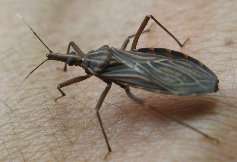Rhodnius prolixus
Rhodnius prolixus is the principal triatomine vector of the Chagas parasite due to both its sylvatic and domestic populations in northern South America as well as to its exclusively domestic populations in Central America. It has a wide range of ecotopes, mainly savanna and foothills with an altitude of between 500 meters to 1,500 meters (1600 feet to 4,900 feet) above sea level and temperatures of 16 °C to 28 °C (61 °F to 82 °F). Sylvatic R. prolixus, as virtually all Rhodnius spp., is primarily associated with palm tree habitats and has a wide range of hosts including birds, rodents, marsupials, sloths, and reptiles.
| Rhodnius prolixus | |
|---|---|
 | |
| Scientific classification | |
| Kingdom: | |
| Phylum: | |
| Class: | |
| Order: | |
| Family: | |
| Subfamily: | |
| Genus: | |
| Species: | R. prolixus |
| Binomial name | |
| Rhodnius prolixus Stål, 1859 | |
The insect was used by Sir Vincent Wigglesworth for the detection of insect hormones. It has been implicated in the transmission of transposons between it and some of its vertebrate hosts, squirrel monkeys and opossums.[1]
Rhodnius prolixus is also known as the kissing bug because it tends to feed on the area around victims' mouths.[2]
History
Rhodnius prolixus established itself throughout Central America after specimens that originated in Venezuela accidentally escaped from a San Salvadoran research laboratory in 1915. It colonized houses and invaded neighboring countries, probably through accidental carriage by travelers.[3]
Life cycle
The insect has five larval stages, with a moult between each. Each larval stage consumes a single large meal of blood, which triggers the moulting process, 12–15 days later. Wigglesworth demonstrated that the moult is started by prothoracicotropic hormone (PTTH) secreted into the blood in response to hormone release by neurosecretory cells in the brain.[4] Further it was demonstrated that the corpora allata secrete the juvenile hormone which prevents the premature development into an adult. The removal of the head during any larval stage causes early development into an adult, whereas the implantation of a juvenile head during the fifth larval stage results in a giant sixth stage larva.[5]
As disease vector
Chagas disease is caused by the parasitic protozoan Trypanosoma cruzi. Infection with Chagas disease occurs after Rhodnius releases protozoans in its feces immediately following a blood meal. The parasite enters the victim through the bite wound after the human host scratches the bite. Infection may also occur via blood transfusion and ingestion of food contaminated with kissing bug feces.
See also
References
- Clément, Gilbert; Schaack, Sarah; Pace II, John K.; Brindley, Paul J.; Feschotte, Cédric (2010). "A role for host-parasite interactions in the horizontal transfer of DNA transposons across animal phyla". Nature. 464 (7293): 1347–50. doi:10.1038/nature08939. PMC 3004126. PMID 20428170.
- http://neurosci.arizona.edu/kissingbugs/basicfacts
- C. J .Schofield (2000). "Challenges of Chagas disease vector control in Central America : position paper". World Health Organization.
- Wigglesworth, V.B. (1934). "The physiology of ecdysis in Rhodnius prolixus (Hemiptera). II Factors controlling moulting and metamorphosis". Q. J. Microsc. Sci. 77: 191–223.
- J. A. V. Butler (1959). Inside the Living Cell. George Allen and Unwin. p. 79.
Further reading
- William C Marquardt et al (2004), Chapter 5: Kissing Bugs and Bedbugs the Heteroptera, Biology of Disease Vectors (2nd edition), Academic Press, ISBN 978-0-12-473276-6
External links
- VectorBase's genomic resource for Rhodnius prolixus
- Rhodnius prolixus from Animal Diversity Web
- General description of Rhodnius prolixus, including blood feeding and sylvatic compounds, from the University of Arizona
- Kissing bugs with bite from the Journal of Young Investigators
- Genome sequencing project at Washington University